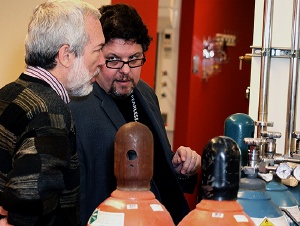Nov 14 2008
UT Dallas researchers will play a key part in a collaborative effort to develop a new nano-scale manufacturing technique that builds three-dimensional objects atom by atom.
 Professor Robert Wallace (right) gives Zyvex founder Jim Von Ehr a tour of his lab at UT Dallas.
Professor Robert Wallace (right) gives Zyvex founder Jim Von Ehr a tour of his lab at UT Dallas.
Part of the Atomically Precise Manufacturing Consortium (APMC) led by Zyvex Labs, a molecular nanotechnology company, the $9.7 million project is intended to accelerate the transition of nanotechnology from the laboratory to the marketplace.
The consortium plans to develop nanotech-based products in volume at practical production rates and costs. Researchers say a host of technologies could result from the work, including high-speed DNA sequencing, next-generation fiber optics and quantum computers.
“The program taps our extensive expertise and capability to manipulate silicon surfaces at the atomic scale and provides a conduit for our research to be translated into viable nanotechnology products,” said Robert Wallace, principal investigator and a professor of materials science and engineering and electrical engineering at the Erik Jonsson School of Engineering and Computer Science at UT Dallas.
UT Dallas researchers will receive nearly $2 million through the program, the largest share of any of the university participants, added Dr. Wallace, who is also a professor of physics. The research will take place in state-of-the-art facilities located in the university’s $85 million Natural Science and Engineering Research Laboratory building.
“The technologies developed by this program will be the first to allow robust three-dimensional solid structures to be created with atomic precision under computer control,” said John Randall, vice president of Zyvex Labs and principal investigator for APMC. “While this falls in line with efforts throughout human history to improve manufacturing precision, it is revolutionary because it will achieve unprecedented precision by taking advantage of the quantized nature of matter.”
The project includes a mix of funding from the Defense Advanced Research Projects Agency (DARPA) and the Texas Emerging Technology Fund.
“Our goal is to develop the capability to fabricate nanostructures in such a way that we can control position, size, shape and orientation at the nanometer scale, which is not possible today,” said Tom Kenny, DARPA program manager. “If we can demonstrate this, we will be able to truly unlock the potential capabilities of nanotechnology.”
APMC’s membership includes Zyvex, General Dynamics, Integrated Circuit Scanning Probe Instruments, Vought Aircraft, UT Dallas, UT Austin, the University of North Texas, the University of Central Florida, the University of Illinois at Urbana-Champaign, the National Institute of Standards and Technology, and the North Texas Regional Center for Innovation and Commercialization.